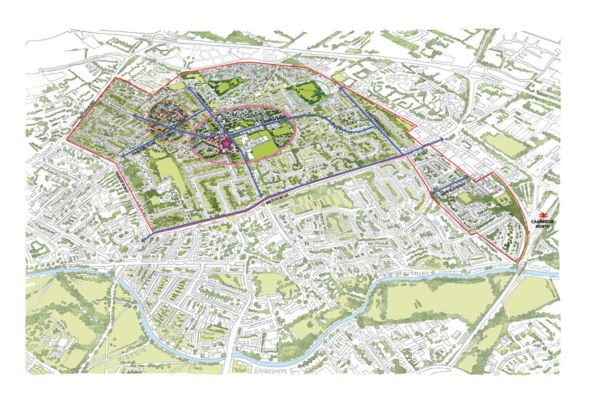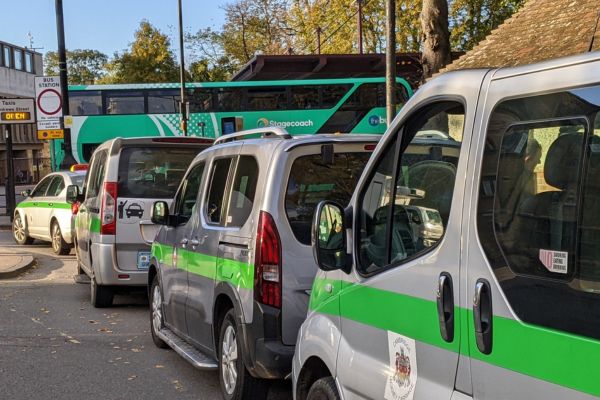We seek to ensure that:
- all phone operators comply with local and central government policies and guidelines
- full and proper consultation is carried out with all parties
- development is designed sensitively to minimise the visual impact
- radiation levels are kept as low as possible and, in any case, below the International Commission on Non-Ionizing Radiation Protection (ICNIRP) guidelines.
Networks and operators
There are five licensed mobile phone operators in the UK:
Each operator needs its own network in order to provide a service. A network comprises a series of radio base stations, each with a coverage area known as a cell. These cells can vary from under 1km in diameter to 20-30km diameter.
The base station comprises a number of antennae, microwave dishes and equipment cabins, which enable mobile phones to connect to each other and to the BT exchange.
The antennae and dishes can either be placed on freestanding masts or on buildings. Some of the smallest base stations are built into street furniture, or are disguised as burglar alarms fixed to walls.
Planning requirements
Apart from some very small installations - for example, microcells which cover a very small area such a few streets - operators will need to apply for some form of consent from the local planning authority prior to installing any equipment.
For smaller masts or smaller installations on buildings, an application for prior approval is required.
For large installations, such as masts over 25m in height, or over 20m within a conservation area, a full planning application will be required.
In either case, the consultation procedure is similar and involves a site notice and letters to local residents. This gives concerned parties an opportunity to express their views to the council. A decision is usually made within eight weeks of the application date.
We have to consider applications in line with the Development Plan, Structure Plan and Local Plan.
Central Government has also published a code of best practice on mobile phone network development.
The Cambridge context
The way in which the city has developed has resulted in a number of constraints which affect all forms of development. These include conservation areas, listed buildings, the green belt and the density of residential development.
For these reasons, great care has to be taken in the choice of location for masts and antennae. This has to be balanced against the increasing demand for mobile services and the government's desire to provide the technology to meet that demand.
The mobile phone operators have agreed on ten commitments in an attempt to improve relations with the public and local authorities.
We encourage pre-application discussions with the operators to ensure that all options are explored. This should enable applications in unsuitable locations to be discouraged early on.
Discussions continue when an application is submitted, often in an effort to minimise the visual impact of the proposed installation.
Operators are encouraged to place antennae on existing masts or buildings to reduce visual impact. Where this is not possible, a new mast may be the only option, but we will ensure that this is sensitively designed and that use is made of existing or new screening, such as trees, fences or buildings.
We have produced a telecommunications design guide [PDF, 23Kb] to promote good practice.
Health issues
Base stations, just like mobile phones, emit radio waves, or electromagnetic fields. Man-made sources of electromagnetic fields also include power lines, broadcasting transmitters, visual display units and television sets.
This radiation has been around for many decades and is an increasing source of concern for members of the public. Despite several studies, there is no conclusive evidence about the safety or harm of electromagnetic fields.
The most significant recent study Mobile Phones and Health, also known as the Stewart Report, concluded:
"The balance of evidence to date suggests that exposures to radio frequency radiation below the National Radiological Protection Board (NRPB) and International Commission for Non-Ionising Radiation Protection (ICNIRP) guidelines do not cause adverse health effects to the general population…
"There is now scientific evidence, however, which suggests that there may be biological effects occurring at exposures below these guidelines…
"We recommend a precautionary approach."
Central government policy states:
"It is the government's firm view that the planning system is not the place for determining health safeguards…
"In the government's view, if a proposed mobile base station meets the ICNIRP guidelines for public exposure it should not be necessary for a local planning authority […] to consider further the health aspects and concerns about them."
The ICNIRP guidelines are a set of radiation levels proposed by an international body. These are used as the maximum recommended levels of radiation for base stations.
With every application, the operators must now include a certificate of compliance with these radiation levels. Without this certificate, the application would not be determined.
All base stations are now designed to be within the ICNIRP guidelines and most operate at fractions of these defined radiation levels. The government has commissioned a series of independent tests of radiation levels from base stations.
We have also carried out a number of independent tests on sites in Cambridge, including the Guildhall. The results showed that all the stations tested operated at fractions of the guideline levels.
We will continue to encourage operators to site stations sensitively and as far away from schools, hospitals and residential areas as possible.
Operators are normally happy to discuss concerns directly with residents, housing groups, businesses, councils and other interested parties.
The Department of Health has further information on these health issues.
Radiation monitoring
In the past, we have commissioned independent radiation monitoring of various sites in the city. These have included council-owned premises as well as sensitive locations, such as near schools or residential properties.
All these tests have shown that the radiation levels at those sites are well within government guidelines.
These tests are limited, however, in that they only take a snapshot of the situation. So, when Vodafone approached us with the idea of installing a permanent radiation monitor, this seemed a worthwhile supplementary method of checking levels.
The monitor is installed on the north side of the city.
It takes readings of all types of electromagnetic fields, not just output from mobile phone masts, within a certain frequency range.
The system is known as Cassiopea and will provide data 24 hours a day, seven days a week and will use Global System for Mobile communications (GSM) technology to send the information from the monitor to a central server.
The objective of the Cassiopea project is to provide a simple and affordable service that can gather and display data for local communities and other stakeholders in a clear and comprehensible manner. It will allow instant verification of the conformity of electromagnetic field levels in the environment to current international guidelines.
Characteristics of the system
- Continuous monitoring 24 hours a day.
- Frequency range 500 kHz to 3GHz.
- Permanent recording of average values over 6 minute periods.
- Despatch of data in encrypted form.
- Archive of files without the possibility of tampering with the management centre's original archived format.
- Data available online.
- Reproducible results.
- Expandable solutions.
How emissions are controlled
Various regulations and guidelines apply to the construction and operation of radio base stations. The most relevant, as far as the public is concerned, relate to their safety.
Government requires all mobile phone installations to comply with the ICNIRP (International Commission on Non-Ionizing Radiation Protection) public exposure guidelines as recommended by the European Union.
The guidelines are frequency-dependent. At 900 MHz the guideline is 4.5 W/m2 (or 41V/m), at 1800 MHz it is 9 W/m2 (or 58 V/m) and at 2100 MHz, it is 10 W/m2 (or 61 V/m).
The results from the monitor are expressed in Volts per metre (v/m).
Research
Research to date has shown that, below guideline levels, there is no evidence of any adverse effects from mobile phone technologies.
Research continues, however, in the form of the Mobile Telecommunications and Health Research Project to which Vodafone, other operators and the government have committed a total of £7 million.
Readings from the Cassiopeia unit in Cambridge
41 V/m is the ICNIRP public exposure guideline for 900MHz, the lowest frequency used by Vodafone. Other mobile phone companies operate at either the same, or higher, frequencies but the guideline figure does not fall below 41 V/m.
It should be noted that council policy as set out in the telecommunications action plan [PDF, 46Kb] requires that emissions from installations on council-owned properties do not exceed 3 v/m.
Contact us (details below) if you have any queries relating to the unit or the results from it.
Where base stations are located
The government keeps a register of base stations nationwide. In addition, they provide us with a register of masts in the city, with information such as address, name of operator, installation details, etc.
The local forum
In October 2001, the city council held a telecommunications seminar in Cambridge which was open to the public. Those attending included council officers and members, local businesses, action groups, experts and representatives from the mobile phone companies.
The seminar provided an opportunity for questioning the companies and independent experts and for open discussion about the relevant issues.
As a result of this seminar, an action plan was drawn up which would explain and put in action the council's policy on telecommunications development in the city. The plan is available by downloading the telecommunications action plan [PDF, 46Kb].
Useful links
The following links provide further information:



